|
A Pictorial Tour of Meihuazhuang's HeartlandMeihuazhuang is an ancient martial art practiced primarily in rural areas in the northern Chinese provinces of Shandong, Henan and Hebei. Because of complex historical circumstances and rigorous rules regarding the acceptance of students, meihuazhuang was practiced for centuries within a strict code of secrecy and close comradery. The meihuazhuang school's involvement in the Boxer Rebellion — the peasant uprising in 1900, led to prohibitions against its practice for many years. In the decades that followed, social unrest and warfare (rampant banditry during the 1930s, World War II and the Japanese occupation, civil war and political movements including the Cultural Revolution) created conditions which essentially isolated the rural "homeland" and forced the practice of meihuazhuang underground. For these reasons, the style is largely unknown in the urban centers of China but is widely practiced by the population of the rural "homeland" regions. Serving as a network for mutual support, solidarity and protection, Meihuazhuang is an important element of rural culture and social organization. 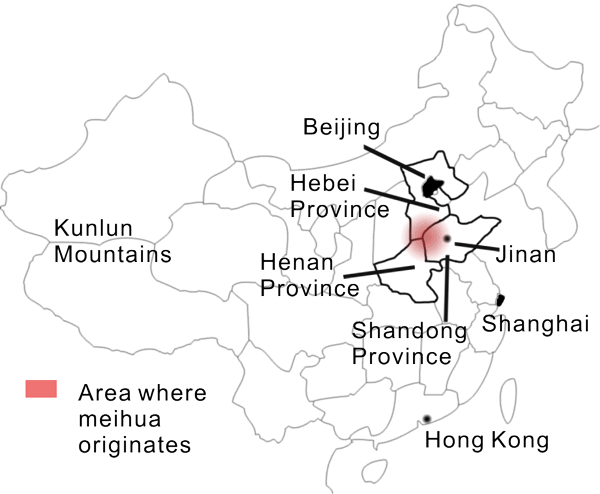
For centuries, rural people practiced martial arts both as a method for defending themselves against roving bandits and also as a method of spiritual cultivation and leisure activity. Every autumn, when the year's agricultural duties are finished, rural people turn their attention to the practice of martial arts. Unencumbered by subsistence agricultural activities, rural people use the winter months to host large scale martial art performances and demonstrations. These festivals, like the one pictured below, have been held for centuries. 
Many thousands of people attend the performances. One of the flags displays the name Yi He Quan — a name used by Meihuazhuang members during the Boxer Rebellion of 1900 to avoid implicating the overall Meihuazhuang movement. While performances are held as festive events throughout the year, the most important take place following Chinese New Year celebrations. At this time, thousands of villagers gather at practice fields to celebrate and display their ancient martial art heritage and exchange knowledge. This particular gathering was held in 1992 Pingxiang County at Baxingzhuang Village. 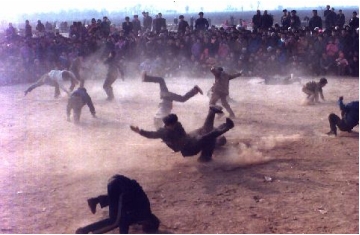
Throwing themselves to the ground, Meihuazhuang practitioners crowd the field demonstrating their training routines, tumbling skills and body conditioning training. Traditionally, performers enter the practice field using flips and somersaults. The masses of students and the clouds of dust create an escalating atmosphere of excitement, festivity, and long history. During performances, the mesmerizing rhythm of drums and cymbals are accompanied by the resounding explosions of giant firecrackers. The distracting, exciting and energizing rhythms and noise are intended to recreate the confusion and clatter which would have been heard on an ancient battlefield and to instill in the crowd and participants a sense of their shared history. These traditions, founded in the distant past, continue to influence rural life. At another demonstration in 1993, thousands of spectators surround the practice field where students of noted meihuazhuang masters perform their routines. Rolling and tumbling in the soil, practitioners stir up clouds of dust which hang in the air and create a foreboding atmosphere of power, focus and skill. Though the region is faced with profound economic challenges, practitioners take great pride in their tradition and its contributions to history. From writings in ancient texts and the myriad of folk histories and legends which abound in the region, practitioners know that Meihuazhuang performances such as this have been taking place for centuries. A prime example occurred In 1896 when the primary organizer of the Boxer Rebellion, Zhao Sanduo and his followers, held a three day competition to intimidate Qing dynasty military forces. 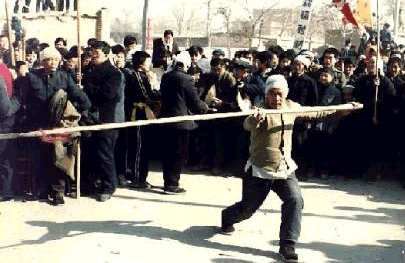
Weapons training such as this spear routine helps to develop strength and coordination in movement and intent. It is not uncommon to see old practitioners or masters performs complex routines such as this. Villagers from near and far travel to take part in exchanges where a great variety of martial performances may be seen. A wide range of weapon routines are common and are characterized by their simple powerful movements and elaborate footwork. Tourists may be interested in rare weapon routines which feature unique weaponry designed primarily to combat 4 metre spears typically utilized by raiding cavalry. These techniques have remained unchanged, proven throughout the years. The character of meihuazhuang forms differs markedly from modern, institutionalized wushu routines and the routines of other martial arts. 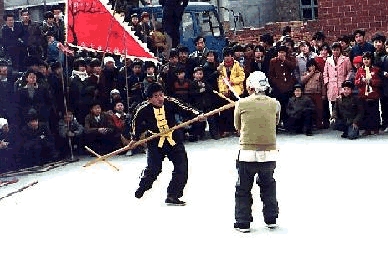
Here at another demonstration in Guangzong County, Hebei, young practitioners and old masters perform open-hand fighting and weapon fighting routines displaying proficienty in many rarely-seen weapons. A meihuazhuang tradition, younger practitioners and old masters often perform together. Young and old practice a wide variety of weaponry including three-sectional staff versus broadsword, staff, sword or other and unusual weapon routines. The two-person routines are stylized prearranged routines which teach essential skills such as timing, distance, and the ability to feel and understand force and how to react to it accordingly. They serve as advanced methods or tools to more finely hone body movement and open-hand martial skills. Because of strict regulations regarding the teaching of Meihuazhuang, the style has been preserved through the centuries in remote rural areas and escaped the devastation experienced by many traditional arts during the cultural revolution. As a result, Meihuazhuang was never popular in major urban areas and, in fact, its existence was almost entirely unknown even among the martial world. In recent years, however, this has begun to change. In the 1950s and 60s, Meihuazhuang was taught in Beijing by the famous master Han Qichang, originally from Wuqiang county, Hebei. One of Master Han's foremost disciples, Mr. Yan Zijie, began publicly teaching Meihuazhuang in the early 1980s and has done much to attract attention to this ancient art. 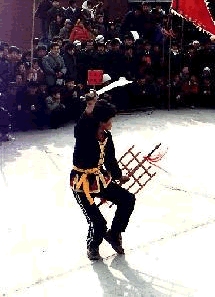
Two-person fighting routines such as this shield-and-broadsword fighting set are common in meihuazhuang. Weapon routines focus on the building of internal strength and are characterized by intricate, light footwork. At Shandong University in the city of Jinan, Professor Yan Zijie was a teacher in the department of mathematics. Everyday after teaching University courses, Professor Yan would bicycle to various campuses throughout the city to teach Meihuazhuang. Each year several hundred students will learn Meihuazhuang under his instruction. Each year over 200 students will begin studying the style. Here, the Master is teaching the basic training set known as the “Framework set.” These movements embody the essence of the style and their mastery is considered the essential basis for more advanced techniques. Demonstrations at the University, held on a regular basis attract new practitioners fascinated by both its physically demanding routines and by its elaborate theory. The commentator at this demonstration says: “Five posture Meihuazhuang follows the traditions of Chinese Traditional Culture. It is characterized by a vast, broad spirit. Its character and spirit is unique and provides obvious results. It is rich in content and consists of both theory and martial practice. The “Framework” is based on the theory of the Yin and Yang and the interaction of the Taiji. Movements should be smooth like a flowing river, never insufficient nor excessive, spontaneous, connected together as one, conforming to the mutual coordination of hard and soft. Static postures will be in accordance with the taiji, as firm as a mountain, movements are like the flowing of a river, the waves on the sea.” 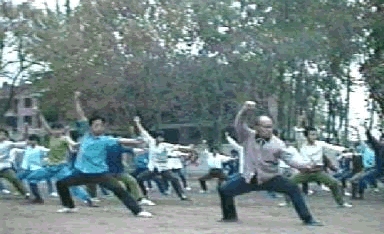
A beginner class A method known as Chengquan trains practitioners in fighting skills. It trains skills in the Upper, Middle and Lower Sections of the body using grabbing, locking, throwing and tripping and striking. Developing these advanced skills requires not only physical skills. Training in this style is guided by theory and to achieve higher martial accomplishments, the students gather to listen to Master Yan's lectures on martial theory. He says: “The shoulder joints and the hips must be relaxed. The posture must be low, relax the shoulders and hips and the qixue will flow open and fluid. Move the flow of qixue in the body to open the qi meridians. This will be very comfortable and give a grand expanded, open feeling in the body and mind. Additionally, when practicing, the eyes must look far off into the distance. In this way the practitioner will develop a spirited, vigorous appearance. This is called developing the spirit (shen) and qi. From the beginning we have the students practice shen, qi and jing together. The three are developed simultaneously. So from the beginning, we must present the theoretical basis. Meihuazhuang develops the internal and external together. What is meant by developing the interior? Jing, Qi and Shen. This Jing, Qi and Shen exist within the body and have no material form or presence. I ask what shape or form they are? Round? Square? You can't say. It has no form and exists inside.” 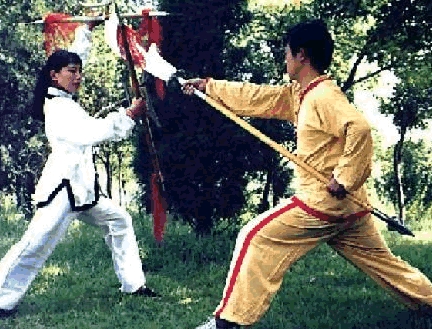
The teacher's daughter and son-in-law are well accomplished in meihuazhuang. Yan Yan and Ren Junmin perform luoziqiang versus guandao. Free fighting skills are essential in Meihuazhuang. After the basic training methods have been thoroughly understood, students may begin learning more advanced fighting techniques. Other than through persistence and hard work, there is no easy way to learn the techniques. In these examples, the master performs the techniques slowly enough for the students to understand. Master Yan's use of theory guides all of the training methods. Basic Stance sets, footwork drills, open hand and weapon routines, locking and free-fighting skills are all based on theory. Theory is taught in conjunction with exercises which develop both the internal and external aspect of the body. 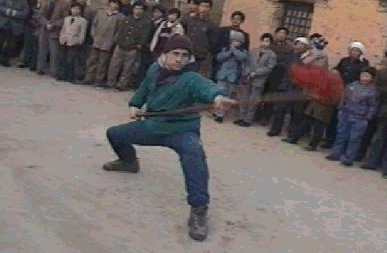
Ray at Zhaofucheng village, Hebei, 1998. All visiting meihuazhuang practitioners are expected to perform as part of an age-old tradition. Meihuazhuang is relatively unknown and thus is an often misunderstood style of Chinese Martial arts. Because of its rich content and significant role in history, it is to our benefit to learn more and enhance our understanding and skills. Also in this section:
|
